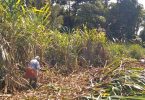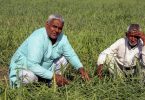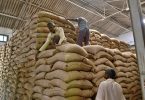[ad_1]
“Hail mother cow, hail mother cow,
Untrustworthy BJP.
The BJP will be sent home,
The BJP is against the cow,
The BJP is against the pastoralist.”
This is what the poster below says in the Gujarati language.

Photo: Author provided
It seems ironic that a political party that prides itself on “protecting” the cow has now come under fire from the Maldharis (a herding community) for being “opposed” to the animal.
Such slogans have been used by the Maldhari community to protest against the BJP government’s recent policies and inattention to the stray cattle situation in Gujarat.

This poster reads: “If not this [cattle], then not that [lotus/BJP] either. It seems like we will have to show these people a ‘stick’ (both a symbol of pastoralism and a weapon).” It speaks of taking strict action against the BJP. Photo: Author provided

This poster sent on a WhatsApp group formed by pastoralists reads: “The BJP has used the weapon of the law on the Maldhari. While the BJP lays a red carpet for industrialists, it jails livestock keepers under the cattle control Bill.” Photo: Author provided
On November 21, the Gujarat Maldhari Mahapanchayat, the umbrella body of cattle rearers in the state, appealed to the community to vote against the BJP in the elections.
Voting in the first phase of the Gujarat assembly elections ended on Thursday, December 1. According to the news agency PTI, a member of the Maldhari community arrived at a polling station in the Rajkot South constituency on Thursday with a cow and a calf in tow. Ranjit Mundhva said he wanted to highlight the hardships that the Maldhari community was facing due to the lumpy virus outbreak.
The second phase of voting will be held on December 5 and results will be announced on December 8.
With about 65 lakh voters, the community has the potential to sway elections in parts of Kachchh, Saurashtra and north Gujarat.
Therefore, it’s pertinent to ask if the BJP government’s ‘cow politics’ is backfiring.
The answer to this question is complex because the community’s position is inflienced by economic, social and political forces.
The BJP and its ‘cow politics’
Since the Narendra Modi government came to power, the cow has become a symbol of political and religious conflict in India. ‘Cow protection’ has long been central to the BJP’s repertoire.
Meanwhile, as right-wing nationalism surges in India, cows seem to have more protection than minority communities.
From holding a national exam on ‘cow science’ (which was later called off due to a controversy over its syllabus) and treating the coronavirus with cow urine to launching the Rashtriya Gokul Mission, the BJP has taken its rhetoric to new levels.
But the cow is not just an animal that has religious significance for Hindus. It contributes significantly to the economy as well. India is home to the most number of cattle in the world. It is the world’s biggest producer of milk and exporter of beef.
As per the annual report of the department of animal husbandry and dairying, the livestock sector accounted for 30.87% of the gross value added (GVA) to the agriculture and allied sectors and 6.17% of the total GVA in 2020-21.
The government also offers huge subsidies to rural households and industries for the development of the dairy industry.
About 30% of the farmers’ income for the rural poor comes from cattle, the report said.
With the growing demand for milk in urban areas, cattle rearing has emerged as one of the most profitable agricultural practices. Selling a cow also provides farmers and landless peasants with an easy way to access cash in times of need.
Yet, the livestock industry remains constrained because of the religious proscription on the consumption of beef. The law also provides for strict penalties if an animal is slaughtered or is being transported for slaughter.
In Gujarat, the transport of animals for slaughter or the buying, selling, and possession of beef is penalised with a prison sentence of no less than 10 years, and a minimum fine of Rs 1 lakh.
Male cows are often abandoned and left to starve, because the mechanisation of agriculture – combined with high fodder costs – has made the roles of bulls disposable for farmers. This has led to a huge stray cattle problem in the country, which is at the core of the current discontent of the pastoral communities in Gujarat.
Interestingly, it has also come up as an election issue in states like Uttar Pradesh and Rajasthan.
The 2011 livestock census backs up these trends. It showed that the female cattle population increased by 18% while the male cattle population decreased by 30.2% from the last census.
It is also under the BJP government that the nation has seen an increase in violence and lynchings in the name of “cow protection” and “vegetarianism”.
Between 2016 and 2020, more than 50 people accused of cow slaughter or trader were killed in India by vigilante mobs. Most of the victims were either Muslims or Dalits.
Meat markets in the national capital remained shut during the Hindu festival of Navratri for fear of violence.
All these instances indicate that livestock traders, butchers, and meat consumers, especially from minority communities, have unduly suffered due to the rise of cow vigilantism.
However, the BJP has neither condemned the vigilantism nor sought to diffuse the fear pervading everyday life. What’s worse, Prime Minister Narendra Modi and his supporters have ‘villainised’ meat consumption, touting it as the ‘pink revolution’.

Members of the Dalit community shout slogans during a protest against a vigilante attack by cow protection groups, in Ahmadabad, India, Friday, July 22, 2016. Photo: PTI
The stray cattle Bill
Mal means livestock or wealth, and dhari means holder or keeper. The Maldharis are the traditional livestock keepers in Gujarat.
It is an occupational identity, politically mobilised by the Hindu Rabari, Bharwad and Charan (and sometimes Ahir) ethnic communities in the state (and also attributed to the Muslim pastoralists, especially in Kachchh.)
These communities trace their origin to religious myths that had assigned them to be livestock keepers, and that is why they continue to practice this profession for generations.
The Gujarat government introduced the Gujarat Cattle Control (Keeping and Moving) in Urban Areas Bill, 2022, in March, which proposed to licence, regulate and prohibit cattle movements in urban areas.
The law, applicable to eight cities and 162 towns in Gujarat, required that cattle keepers apply for a licence to keep livestock within urban limits and tag their animals. Further, the Bill also included a hefty penalty of Rs 5,000 to Rs 50,000 if a cow was impounded.
The Maldhari community found the provisions of the Bill stringent and unfair, and therefore, led a massive protest campaign from April onwards.
The protests and counter-actions peaked in September, when the community stopped the supply of milk in the cities. In south Gujarat’s Surat, they threw milk packets in the Tapi river as a sign of protest.
After massive protests, the BJP government had to revoke the Bill on September 22.
However, the problem still persists.
The government’s economic liberalism, and the booming market, especially for milk, combined with their ‘religio-political illiberalism’ has led to huge cattle populations without adequate provisions to look after them. Grazing land, for example, has been shrinking in the wake of growing urbanisation and industrialisation.
The government provides 40 acres of grazing land per 100 heads of cattle. However, according to the state revenue minister’s written replies to the assembly in March, 9,029 villages have less than the minimum grazing land, while as many as 2,614 villages have no gauchar land at all.
One of the solutions to the problem of excess cattle is the development of panjrapols (asylums for old and unserviceable animals) and gaushalas (cowsheds), donating to which is increasingly considered a noble form of charity in the state. These institutions serve as shelters for stray animals, where they are kept, fed, and treated for illnesses.
The Gujarat government’s Gauseva and Gauchar Vikas Board (Cattle Welfare and Fodder Development Board) also claims to provide these services. The government also allotted Rs 500 crore under the Mukhyamantri Gaumata Poshan Yojana (cattle feeding scheme) to provide gaushalas with Rs 30 per animal to improve their capacity to care for and house livestock.
Yet, disbursements under this scheme are still pending, further adding to the Maldhari community’s frustration.
The demand for rights
Despite the revocation of the Stray Cattle Bill, the Maldhari community continues to oppose the BJP for its failure to meet the additional demands. These demands include a Scheduled Tribe status for the pastoralists of the Gir, Barda and Alech forested regions, the development of Maldhari vasahat (settlement), and the designation of farmer status.
Their demand for an ST status has been long-running. In 2020, the community held rallies in Porbandar when government exams excluded them from the ST reservation list.
The Maldharis have a strong relationship with their landscape.
Earlier, they would travel long distances and were able to find fodder for their animals, even in the arid dryland regions of Gujarat. They were able to raise livestock even when their crops would fail. This put them in a proud and privileged position and positioned them as dominant caste-class groups.
But now with industrial and agricultural development, the pastoralists find themselves at a disadvantage, and politically marginalised.
Therefore, even though they may consider themselves ‘above’ Adivasi and tribal populations in the social hierarchy, they seek an ST identity, as forest dwellers in these areas, to receive wider benefits and inclusions.
Even though the Maldharis had resisted settlement in the past, they are now demanding it.
Mobility and shared resource use have been key to livestock keeping and the health of the landscape for them.
Yet, pastoralists across the world, including in India, have been misunderstood for their mobility, criminalised, and made to settle by colonial and post-colonial governments. While Gujarat’s Maldharis had escaped such settlement schemes, partly due to their social position, their demand for a settlement is not unusual because having territory, permanent homes and a settled lifestyle symbolises progress and development.

Maldharis in the Banni region of Gujarat. Photo: Kabir Agarwal
Moreover, as mentioned earlier, their resource use has been restricted by the growth of commercial agriculture and industry. Without any settlement and the status of a farmer, they are unable to access support schemes and amenities, such as schooling, insurance, and input subsidies, available to others in the state.
The biggest indication of their desire to come to the mainstream is within the cause itself. While accusing the BJP of being “cow haters”, they are projecting themselves as “cow lovers”, thereby deploying the same ‘cow politics’ instrumentalised by the BJP and other political parties as well.
However, while doing so, they sometimes ignore the needs of many within their own community.
Many Maldharis across the state also keep small ruminants such as sheep, goats, and camels. Mobility is even more essential for keeping such livestock as unlike cattle, sheep and goats cannot be stall-fed and raised in enclosed spaces.
At the same time, with the collapse of the indigenous wool market, the main source of income for these pastoralists is the sale of animals for meat, both domestically and internationally.
While this has been the mainstay of the community for generations, it is increasingly being seen as ‘paap no dhandho’ or sacrilegious work by the rural society, leading them to choose alternative means of livelihood such as cattle keeping.
Livestock policies in Gujarat consider small ruminants as “unproductive” animals as they do not contribute to the dairy value chain, and that’s why, they do not receive benefits such as veterinary services, livestock insurance or loans, or market protections.
The community council has not raised the need for improved policies for these livestock keepers. Nor has there been any action against the restrictions on livestock export, including the closing of the Tuna port – the main port in Kachchh from where these animals are exported. The same animal welfare groups that run the gaushalas are often behind port closure.
Therefore, the Maldharis too are strategically trying to leverage their livelihood and identity towards the goals they consider valuable.
Natasha Maru is a social scientist and policy consultant working on pastoral development. She recently finished a PhD with the Pastoralism, Uncertainty and Resilience (PASTRES) project hosted by the Institute of Development Studies, UK, for which she worked with the Rabari pastoralists of western India.
[ad_2]
Source link







